List of military clothing camouflage patterns
.jpg)
1931 Splittertarnmuster (splinter pattern) first used for tents, then parachutists' jump smocks, and finally for infantry smocks
This is a list of military clothing camouflage patterns used for battledress. Military camouflage is the use of camouflage by a military force to protect personnel and equipment from observation by enemy forces. Textile patterns for uniforms have multiple functions, including camouflage, identifying friend from foe, and esprit de corps.[1]
The list is organized by pattern; only patterned textiles are shown. It includes current and past issue patterns, with dates; users may include armed, paramilitary, police, firefighting, search and rescue, counter-insurgency/counter-terrorism and other security forces and emergency services.
Patterns
| Name | Family | Image | Issued | Users |
|---|---|---|---|---|
| Australian Multicam | Woodland |  | 2014 | Australia[2] |
| Airman Battle Uniform (ABU) | Digital tigerstripe | 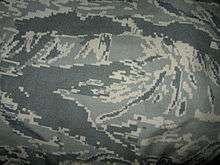 | 2008 | Used by the United States Air Force and the U.S. Civil Air Patrol.[3][4][5] |
| AOR-1 (NWU Type II) | Digital | _Type_III_camouflage_pattern_swatch%2C_AOR-1.png) | 2010 | United States Navy, certain specialized units only.[6][7] |
| AOR-2 (NWU Type III) | Digital |  | 2010 | United States Navy, specialized units before 2016, fleet-wide after 2016.[8] |
| A-TACS | Woodland | 2010 | Unlicensed copies are used by the Russian Federation under the name of "Ataka".[9] | |
| Bundeswehr Tropentarn (3-Farb-Tarndruck) | Flecktarn |  | 1993 | German Bundeswehr:[10] tropical battle dress uniform for desert and semi-arid regions (army and air force) |
| Canadian Disruptive Pattern (CADPAT) | Digital | 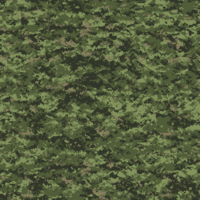 | 2002 | Canada. Temperate variant shown.[11] |
| Camouflage Europe Centrale | Woodland |  | 1991 | France, Austria[12] |
| Desert Camouflage Pattern (three-color) | Woodland |  | 1991 | United States[13] |
| Desert Camouflage Pattern (six-color) | Woodland |  | 1980s | United States (formerly).[14] Used by many other armies in many colour and pattern variations, including Argentina, Dominican Republic, El Salvador, Kuwait, Niger, Paraguay, Peru, China, Egypt, Eritrea, Iran, Iraq, Jordan, Kazakhstan, Libya, Pakistan, Philippines, Rwanda, Saudi Arabia, Somalia, South Korea, Spain, UAE, Yemen.[15] |
| Desert Night Camouflage | | 1991 c. | United States (formerly)[16] | |
| Disruptive Pattern Material | DPM | 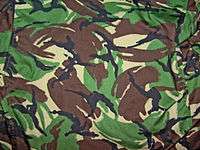 | 1968 | United Kingdom, DPM-95 shown. It replaced similar 1960 pattern DPM, introduced in 1968.[17] Replaced by Multi-Terrain Pattern. Iceland,[18] Indonesia, Netherlands, New Zealand, Philippines, Russia, Yemen. |
| Erbsenmuster | Flecktarn | .jpg) | 1944 | Germany[19] |
| ERDL (M1948) | Woodland |  | 1967 | Singapore Armed Forces,[20] Turkish Armed Forces late 1980s–1990s,[21] was used by the USMC until the early 1980s. |
| Flächentarnmuster, also called Kartoffelmuster (potato), or Blumentarn (flower) | Flecktarn | | 1956–1967 | East German National People's Army[22] |
| Flecktarn | Flecktarn | 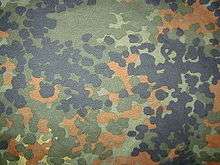 | 1990 | Germany,[23] and at least 16 variants in different countries. Albania;[24] Belgium;[25] China until 2007;[26] Denmark 3-color variant;[27] France;[28] India;[29] Japan;[30] Kyrgyzstan;[31] Poland;[32] Russia;[9] Greece, Ukraine. |
| Frog Skin/Spot | Frog Skin |  | 1942 | United States. Reversible: 5-color jungle one side, 3-color beach the other.[33] Also used by Turkey until 1980s in different colorways.[21] |
| Jigsaw | Puzzle | .jpg) | 1956 | Belgium[34] |
| Leibermuster |  | 1945 | Germany[35] | |
| Lizard | Lizard |  | 1947 | France[36] Many variants, both with horizontal stripes (Chad, Gabon, Rwanda, Sudan, Cuba, Congo, Greece) and with vertical stripes (Portugal 1963, then Egypt, Greece, India, Lebanese Palestinians, and Syria). Vietnam era Tigerstripe is a variant of Lizard.[36] |
| M05 | Digital |  | 2007 c. | Finland[37] |
| M84 | Flecktarn | 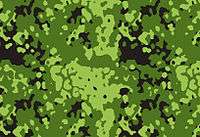 | 1984 | Denmark; 9 color variants.[38] Estonia:[39] France;[27][40][41] Latvia;[39] Lithuania;[39] Russia;[27] Sweden;[42] Turkey[43] |
| M90 | Splinter |  | 1989[44] | Sweden;[45] Latvia;[46] |
| Marina Trans Jungle (US4CES) | Digital | 2015 | Mexican Naval Infantry[47] | |
| Marine Pattern (MARPAT) | Digital | 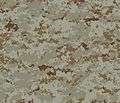 | 2002 | United States Marine Corps (arid variant shown),[48][49] some U.S. Navy sailors assigned to USMC units, and U.S. Marine Corps JROTC cadets. The temperate variant was used by the Georgian Army in the late 2000s, but has since been replaced by a domestic variant of MultiCam.[50] |
| MultiCam | Woodland |  | 2002 | U.S. Armed Forces,[51] Angola,[52] Brazil,[53] Australia,[54][55] Austria,[56] Denmark,[27][38] Montenegro,[57] New Zealand,[58] Panama,[59] South Korea,[60] Thailand,[61] Tunisia,[62] Turkish Navy[21] Azerbaijani Armed Forces, the Canadian Special Operations Forces Command, Georgian Armed Forces,[63] and the Haitian National Police.[64] |
| Multi-Terrain Pattern | Disruptive Pattern Material |  | 2010 | British Armed Forces[65] |
| NWU Type I | Digital |  | 2008–2019 | United States Navy,[66] New York State Naval Militia,[67] and U.S. Naval Sea Cadet Corps.[68] Due to be retired by the U.S. Navy in 2019. |
| Operational Camouflage Pattern (OCP) | Woodland | _swatch.png) | 2015 | United States, replacing Universal Camouflage Pattern by 2019.[69] Also known as Scorpion W2. |
| Platanenmuster | Flecktarn |  | 1937 | Germany: summer (shown) and autumn variants.[19] |
| Rain pattern | Rain | | 1960 c. | Warsaw Pact countries: Poland ("deszczyk"), Czechoslovakia ("jehličí"), East Germany ("Strichtarn"), and Bulgaria[70][71] subsequent use: Uzbekistan, Kazakhstan |
| Rhodesian Brushstroke | Brushstroke | 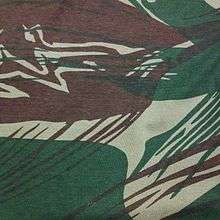 | 1965–1980 | Rhodesia[72] |
| Soldier 2000 | Woodland |  | 1994 | South Africa[73] |
| Splittermuster | Splinter | .jpg) | 1931 | Germany 1941–1944 (Wehrmacht, SS)[74] |
| Tactical Assault Camouflage (TACAM) | Woodland | | 2004 | U.S. National Counterterrorism Center[75][76] |
| TAZ 90 | Woodland | 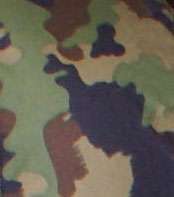 | 1990s | Switzerland[77] |
| Telo mimetico | Woodland precursor | 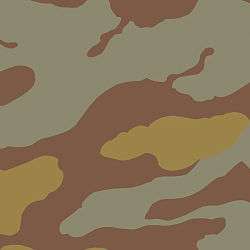 | 1929 | Italy, for shelter-halves, then uniforms. Oldest mass-produced camouflage pattern.[78] |
| Tigerstripe | Tigerstripe |  | 1969 c. | South Vietnam, US special forces in Vietnam. Based on Lizard. Many variants. Also used by Australia, New Zealand in Vietnam.[79][80] |
| Turkish pattern | semi-Digital |  | 2008 c. | Turkish Armed Forces[81] 5 variants[21] Azerbaijani Armed Forces |
| Type 99 (China) | Woodland |  | 1999 | China[82] |
| Type 07 (China) | Digital |  | 2007 | China. Ocean variant shown.[82] |
| Universal Camouflage Pattern | Digital |  | 2005–2014/19 | United States Army,[83] some U.S. Navy sailors assigned to army units,[84] the Texas State Guard,[85] Chadian Army,[86] and the Azerbaijani Armed Forces. Also used by the Iranian military in limited contexts. |
| U.S. Woodland (M81) | Woodland | 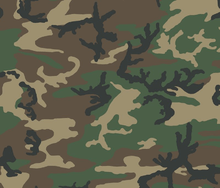 | 1981 | Derived from ERDL.[87] Used by the United States Navy SEALs, U.S. Navy SWCC, USMC MARSOC,[88] Luxembourg,[89] Azerbaijani Armed Forces, the Dutch Marine Corps,[90] and the Nigerian Navy.[91][92] Was used by the Afghan National Army and the Mexican Naval Infantry[93] in the 2000s. Also used by the Malaysian navy,[94] and Turkey until mid-2000s in 3 colorways.[21] |
| wz. 68 Moro |  | 1969–1989 | Poland; 6 variant colorways.[95][96][97] | |
| wz. 89 Puma | 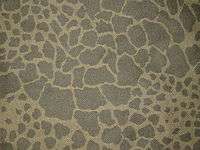 | 1989–1993 | Poland[98] | |
| wz. 93 Pantera | Woodland | 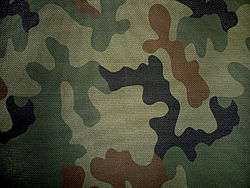 | 1993 | Poland[99] |
References
- ↑ Brayley, Martin J. (2009). Camouflage Uniforms: International Combat Dress, 1940–2010. Ramsbury: Crowood. ISBN 1-84797-137-7.
- ↑ "Australia - Soldier Systems Daily | Australian Multicam Camouflage Uniform Officially Launched". soldiersystems.net. Retrieved 2015-02-14.
- ↑ "The ABU and its Poor Implementation in Civil Air Patrol". 7 May 2016.
- ↑ "AF Airman Battle Uniform (ABU) updates and Wear Instructions". capnhq.custhelp.com.
- ↑ http://www.capmembers.com/media/cms/CAP_Transition_to_ABUs_06DC64FB17483.pdf
- ↑ Directorate, Navy Production. "10 Things You Need To Know:".
- ↑ https://www.navfac.navy.mil/products_and_services/ex/products_and_services/SYSCOM/uniforms/nwu.html
- ↑ Affairs, This story was written by Chief of Naval Personnel, Public. "NWU Type III Transition Begins - 5 Things You Should Know".
- 1 2 "Russia - Camopedia". camopedia.org.
- ↑ "Uniformen der Bundeswehr" (in German). Bundeswehr. Retrieved 22 August 2016.
- ↑ CADPAT on the Canadian Army website
- ↑ "French CCE Camouflage T-shirt". Epic Militaria. Retrieved 26 March 2016.
- ↑ "Desert BDU". Archived from the original on 4 May 2017. Retrieved 14 May 2017.
- ↑ United States Army (2005). "Army Regulation 670-1: Wear and Appearance of Army Uniforms and Insignia" (PDF). United States Department of Defense. Archived from the original on April 28, 2005. Retrieved April 28, 2005.
- ↑ "Chocolate Chip Camouflage". Camopedia. Retrieved 26 March 2016.
- ↑ "Desert Night Camouflage Trousers, Size: Small Long, NSN: 8415-01-102-6290". Military Steals and Surplus. Retrieved 26 March 2016.
- ↑ "Trousers, Camouflage DPM Combat Dress 1968 pattern". Imperial War Museum. Retrieved 31 October 2015.
- ↑ "Iceland". SFOR Informer Online. NATO. Retrieved 27 March 2016.
- 1 2 Newark, Tim (2007). Camouflage. Thames and Hudson. pp. 133–137. ISBN 978-0-500-51347-7.
- ↑ Singapore_ERDL
- 1 2 3 4 5 "Turkey". Camopedia. Retrieved 13 October 2014.
- ↑ "East German Camouflage Patterns". Henrikc.dk. 2011-12-31. Retrieved 2012-02-20.
- ↑ Newark, Tim (2007). Camouflage. Thames and Hudson, with Imperial War Museum. ISBN 978-0-500-51347-7. Page 157.
- ↑ "Albania". SFOR Informer Online. NATO. Retrieved 27 March 2016.
- ↑ "Belgium - Camopedia". camopedia.org.
- ↑ "China - Camopedia". camopedia.org.
- 1 2 3 4 "Danish M/84 "Pletsløring" camouflage pattern". Strike - Hold!. Retrieved 1 April 2016.
- ↑ "France - Camopedia". camopedia.org.
- ↑ "India - Camopedia". camopedia.org.
- ↑ "Japan - Camopedia". camopedia.org.
- ↑ "Kyrgyzstan - Camopedia". camopedia.org.
- ↑ "КАМУФЛЯЖ URBAN FLECKTARN". Camo-info. Retrieved 27 March 2016.
- ↑ "Eastman: Frog Skin pattern".
- ↑ "Belgian Camouflage Patterns". Camopedia. Retrieved 26 March 2016.
- ↑ Richardson, Francis. (1945). "Camouflage Fabrics both Plain and Printed for Military Use by the German SS and German Army." Reprinted in: Borsarello, J.F. (Ed.). (1990?). SS & Wehrmacht Camouflage, ISO Publications; London.
- 1 2 "Lizard". Camopedia. Retrieved 25 March 2016.
- ↑ Licence of M05/M04 Design at site of National Board of Patents and Registration of Finland Archived July 20, 2011, at the Wayback Machine.
- 1 2 "First Official Look at the New Danish Uniform". Krigeren (in Danish). Retrieved 27 February 2015.
- 1 2 3 "Baltics and Danes live, task together". SFOR Informer Online. NATO. Retrieved 27 March 2016.
- ↑ "Recruitment Campaign 2014/2015". Facebook. Retrieved 18 February 2016.
- ↑ "13e Régiment de Dragons Parachutistes" (in French). le.cos.free.fr/. Retrieved 18 February 2016.
- ↑ "Swedish National Task Force (Nationella insatsstyrkan) during the hunt for cop killer Tony Olsson and other convicts after an escape at the Hall institution.". military66.com. Retrieved 27 March 2016.
- ↑ "Yenigün" (in Turkish). Retrieved December 16, 2014.
- ↑ "Sweden". Camopedia. Retrieved 2 June 2016.
- ↑ "Swedish M/90 and M/90K camouflage". Strike – Hold!. April 11, 2009.
- ↑ "Latvia". SFOR Informer Online. NATO. Retrieved 27 March 2016.
- ↑ "US4CES - Soldier Systems Daily". soldiersystems.net.
- ↑ Blechman, Hardy; Newman, Alex (2004). DPM: Disruptive Pattern Material. Department of Publications. ISBN 0-9543404-0-X.
- ↑ Jontz, Sandra (February 24, 2001). "Marines' followed Canadians' example in use of digitally-designed 'cammies'". Stars and Stripes. Archived from the original on December 27, 2007. Retrieved 14 January 2010.
- ↑ "File:USMC-110217-M-8715L-002.jpg" – via Wikipedia. External link in
|title=(help) - ↑ "US Army Camouflate Improvement Effort Update". 24 July 2013.
- ↑ "GRUPO MILÍCIA, 20 ANOS DE ACTIVIDADE | Operacional". operacional.pt. Retrieved 2015-09-06.
- ↑ "Conheça o treinamento do Comando de Operações Táticas da Polícia Federal (COT) | Fotos". veja.abril.com.br. Retrieved 2015-09-06.
- ↑ New combat uniform makes troops job easier, Australian Department of Defence, 19 November 2010.
- ↑ Land Warfare Conference - Minister for Defence Materiel, Australian Department of Defence, 19 November 2010.
- ↑ "50 JAHRE JAGDKOMMANDO | DOPPELADLER.COM". doppeladler.com. Retrieved 2015-09-06.
- ↑ "Montenegro Military in MultiCam - Soldier Systems Daily". soldiersystems.net. Retrieved 2015-09-06.
- ↑ Cheng, Derek (2 July 2011). c_id=1&objectid=10735872 "SAS war kit blows away military fans" Check
|url=value (help). The New Zealand Herald. Retrieved 2011-07-02. - ↑ https://www.flickr.com/photos/kormnd/8399595823/in/set-72157632569761987 ROK Ministry of National Defense, Defense Media Agency flickr page, 2013,01,18
- ↑ "กองบัญชาการกองทัพไทย". Archived from the original on 2013-12-24. Retrieved 2015-09-06.
- ↑ "Archived copy". Archived from the original on 2014-02-22. Retrieved 2014-02-08.
- ↑ "File:A Georgian soldier with Scouts Platoon, Delta Company, Special Mountain Battalion conducts reconnaissance operations Feb. 14, 2014, during Georgian Mission Rehearsal Exercise (MRE) 14-02B at the Joint 140214-A-HJ139-001.jpg" – via Wikipedia.
- ↑ "Photo Gallery: Haiti Jovenel Moise Inauguration". 2017.
- ↑ Copping, Jason (20 December 2009). "British Army to get new uniforms – turned down by the US and made in China". The Daily Telegraph. Retrieved 22 January 2014.
- ↑ Affairs, This story was written by Chief of Naval Personnel Public. "Navy Working Uniform Details and Instructional Video Announced".
- ↑ "New York Naval Militia trains on Hudson River".
- ↑ Joe P (30 July 2012). "USNSCC Buffalo, NY Summer Trainings" – via YouTube.
- ↑ Tan, Michelle (3 April 2015). "Army chief shares update on new camo rollout". Army Times.
- ↑ Shuck, David (27 January 2015). "Understanding Camo: The 13 Patterns to Know". Heddels.com. Retrieved 26 March 2016.
- ↑ "Rain patterns". Camopedia. Retrieved 26 March 2016.
- ↑ Baumbach, Johannes (2012). Sparks, Emma, ed. Advances in Military Textiles and Personal Equipment. Cambridge: Woodhead Publishing. pp. 80–81. ISBN 978-1845696993.
- ↑ "South Africa - Camopedia". camopedia.org.
- ↑ German Army Uniforms and Insignia 1933-1945, Brockhampton Press (2000), ISBN 978-1-86019-869-4
- ↑ "HyperStealth Biotechnology Corp". Hyperstealth.com. Retrieved 2012-02-20.
- ↑ Crane, David (15 March 2005). "Robo-Soldier Ready for Combat Deployment to Iraq for Urban Warfare/CI Ops". Defense Review. Retrieved 26 March 2016.
- ↑ "Swiss Camouflage Patterns". Camopedia. Retrieved 26 March 2016.
- ↑ "Italian Camouflage Patterns". Camopedia. Retrieved 26 March 2016.
- ↑ McNab, Chris (2002). 20th Century Military Uniforms (2nd ed.). Kent, UK: Grange Books. ISBN 1-84013-476-3.
- ↑ Johnson, Richard Denis (1999). Tiger Patterns: A Guide to the Vietnam War's Tigerstripe Combat Fatigue Patterns and Uniforms. Schiffer Pub Ltd. ISBN 978-0-7643-0756-0.
- ↑ "Türk Ordusu'na yeni üniforma - GAZETE VATAN".
- 1 2 "Camouflage Patterns of the Chinese Armed Forces". Camopedia. Retrieved 26 March 2016.
- ↑ "ACU Presentation". ArmyStudyGuide.com.
- ↑ http://www.public.navy.mil/IA/Documents/NAV10116.txt
- ↑ BurnsCreative (17 May 2011). "TeXas State Guard Basic Orientation Training" – via YouTube.
- ↑ "The Chadian army unit in charge of the anti-poaching effort". National Geographic Society (blogs). 5 February 2013.
- ↑ "Woodland Camouflage". Camopedia. Retrieved 26 March 2016.
- ↑ "MARSOC adopts woodland Crye Precision uniform - Kit Up!". 22 August 2011.
- ↑ "Luxembourg". SFOR Informer Online. NATO. Retrieved 27 March 2016.
- ↑ https://thumbs.dreamstime.com/z/dutch-royal-marines-reserves-15933147.jpg
- ↑ "Wayback Machine". web-beta.archive.org.
- ↑ "Wayback Machine". web-beta.archive.org.
- ↑ "Defense.gov - Photos". www.defense.gov.
- ↑ "File:Navy PASKAL rifleman with HK XM8 Compact Carbine 9 inches on standby 57th NDP.JPG" – via Wikimedia Commons.
- ↑ Henryk Wielecki, Dzieje polskiej rogatywki, Warszawa 1985, s. 107; cyt ..z tkaniny polowej popularnie nazywanej „mora”...
- ↑ Jacek Kijak, Hełmy Wojska Polskiego 1917–2000, Warszawa 2013, s. 86
- ↑ Praktyczny słownik współczesnej polszczyzny, red. Halina Zgółkowa, t. 22, Poznań 1999, s. 28
- ↑ "Mundur Polowy wz.89 "Puma"".
- ↑ Hubert Królikowski (2001). "Barwa". Specjalna Formacja Wojskowa GROM im. Ciechociemnych Spadochroniarzy Armii Krajowej (in Polish). p. 133. ISBN 83-915131-0-6.
External links
This article is issued from
Wikipedia.
The text is licensed under Creative Commons - Attribution - Sharealike.
Additional terms may apply for the media files.
.jpg)